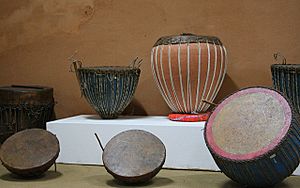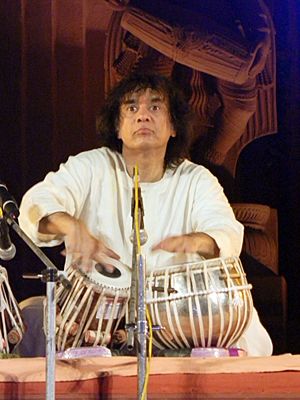Tabla facts for kids
 |
|
Quick facts for kids Percussion instrument |
|
|---|---|
| Classification | Indian percussion instrument, goatskin heads with syahi |
| Playing range | |
| Bolt tuned or rope tuned with dowels and hammer | |
| Related instruments | |
| Pakhavaj, mridangam, khol, dholak, nagara, madal, tbilat | |
The tabla is a cool Indian drum used in North Indian music. It was invented in India. People also use it in classical, popular, and religious music in Pakistan. The tabla is actually two hand drums. They are different sizes and shapes, a bit like bongos. Each drum makes a different sound. One is a higher-pitched drum, and the other is a lower-pitched drum.
You play the tabla by tapping your fingers on the drum head. You can also slide your palm to make the sound change. You can create many different sounds from the tabla by changing how you use your hands.
The tabla came from an older, cylindrical drum called the Pakhawaj.
Zakir Hussain is a very famous tabla player. There are different Gharanas, or styles, of tabla playing. Zakir Hussain's style comes from the Punjab Gharana.
Contents
Where Did the Tabla Come From?
The exact history of the tabla is a bit of a mystery. There are a few ideas about where it started. Some people think it came from Muslim and Mughal rulers who came to India. Others believe it came from ancient Indian traditions.
One idea for its Indian origin comes from old carvings in the Bhaja Caves. These carvings show a woman playing two drums. Some people think these are early versions of the tabla. However, clear pictures of the tabla as we know it only started appearing around 1745. The drum kept changing its shape until the early 1800s.
Ancient Indian Roots
The idea that the tabla came from India points to very old civilizations. The stone carvings in Bhaja Caves show a woman playing a pair of drums. Some say this proves the tabla is very old in India. Another idea is that the tabla got a new Arabic name during Islamic rule. This theory suggests it grew from ancient Indian puskara drums.
You can see pictures of hand-held puskara drums in many temple carvings. For example, at the 6th and 7th century Muktesvara and Bhuvaneswara temples in India. These artworks show drummers sitting with two or three small drums. Their hands look like they are playing these drums. But it's hard to tell if these old drums were made of the same materials or played the same way as the modern tabla.
Old Sanskrit texts also talk about how to build musical instruments like the tabla. The Hindu text Natyashastra describes how to make paste-patches (called syahi). These are the black circles you see on a tabla. The Natyashastra also explains how to play these drums. Another old text, Silappatikaram, from the early 1st millennium CE, describes thirty types of drums. But these drums are called pushkara, not tabla. The name tabla appeared later.
Theories from Muslim and Mughal Times
This idea connects the word tabla to the Arabic word tabl, which means "drum." Some say that Muslim armies had many soldiers on camels and horses carrying paired drums. They would beat these drums to scare people and other armies when they invaded India. However, these war drums, called naqqara, looked and sounded very different from the tabla. They were much larger.
Another story says that Amir Khusraw, a musician from the 13th century, invented the tabla. He supposedly cut an hourglass-shaped drum called an Awaj into two parts. But there are no old paintings, sculptures, or documents from his time that support this story. Also, a list of musical instruments written by a Muslim historian in the 16th century, Abul Fazi's Ain-i-akbari, does not mention the tabla.
A third story gives credit to an 18th-century musician, also named Amir Khusru. This story says he cut a Pakhawaj drum in half to create the tabla. Some old paintings from this time show instruments that look a bit like the tabla. This idea suggests the tabla came from within the Muslim community in India. However, experts like Neil Sorrell and Ram Narayan say this story of cutting a pakhawaj in half is probably not true.
A Look Back: Tabla's Journey Through Time

Drums and musical rhythms called Talas are mentioned in very old Vedic texts. Before the 5th century, a percussion instrument with two or three small drums, held with strings, was used in India. It was called Pushkara. Other drums like the Mridang also existed. But they were not called tabla back then.
Paintings from before the 5th century in the Ajanta Caves show musicians playing small, tabla-like drums. They are sitting upright. They also play a kettle-shaped mridang drum and cymbals. Similar stone carvings of musicians playing drums are found in the Ellora Caves and other places.
Tibetan and Chinese monks who visited India in the first 1000 years CE also wrote about small Indian drums. They mentioned them along with many other musical instruments. The pushkala drums are called rdzogs pa in Tibetan writings. These drums are also mentioned in many ancient Jainism and Buddhism texts.
Many Hindu and Jain temples, like the Eklingji in Udaipur, Rajasthan, have stone carvings. They show people playing small, tabla-like drums. Small drums were popular during the Yadava rule (1210 to 1247) in the south. This was when the book Sangita Ratnakara was written.
A 14th-century poet named Madhava Kandali listed several instruments in his version of the Ramayana. He mentioned "tabal," which suggests these instruments existed in his time or even earlier. There are also recent pictures of the tabla from 1799. But the carvings in Bhaja caves give strong proof that the tabla was used in ancient India. Some Hindu temple carvings of double hand drums that look like the tabla date back to 500 BCE. The tabla was played widely across ancient India. A Hoysaleshwara temple in Karnataka even shows a carving of a woman playing a tabla while dancing.
According to old Indian music rules in the Natyashastra, the Tabla is a Avanadha Vadya instrument. This means it's a rhythm instrument made by stretching skin over an empty pot or vessel.
How the Tabla is Built
The tabla is made of two single-headed drums. They are shaped like barrels and are slightly different in size. They are called baya and daya for the left and right drums.
The smaller drum is played with your main hand (usually the right hand). It's called dayan (meaning "right side"). It's correctly called the "tabla." It's made from a cone-shaped piece of teak or rosewood. The wood is hollowed out about halfway. The daya tabla is about 15 centimeters (6 inches) across and 25 centimeters (10 inches) tall. This drum is tuned to a specific musical note. This note usually matches the main note of the song, helping the melody. You can only tune it within a certain range. Different dayans are made in different sizes, each with its own tuning range.
Small wooden blocks, called gatta, are placed between the straps and the drum shell. You can move these blocks up or down to change the tightness of the drumhead. To fine-tune the drum, you tap vertically on the braided part of the drumhead with a small, heavy hammer. While a tabla usually has two drums, a tabla tarang can have 10 to 16 dayas. These are used to play melodies based on different ragas (musical scales).
The baya tabla is bigger and shaped like a deep kettle drum. It's about 20 centimeters (8 inches) across and 25 centimeters (10 inches) tall. You play it with your non-dominant hand (usually the left). It's called bāyāñ (meaning "left"). It makes a much deeper bass sound, like a kettle drum. Bāyāñs can be made from different materials. Brass is common, but copper is more expensive and often thought to be the best. Cheaper ones are made from aluminum and steel. Sometimes wood is used, especially in old bāyāñs from Punjab. Clay is also used, but it's not as strong. These are usually found in Bengal. The baya is tuned about a fifth to an octave lower than the daya drum. The player uses the heel of their hand to press on the drum. This changes the pitch and sound color of the drum during a performance.
Each drum's head has a black circle in the middle. This is called the syahi (meaning "ink"). Syahi is found on many Indian drums. This special paste helps the drums make harmonic overtones. This gives them their unique, bell-like sound. Syahi is made from many layers of a paste. This paste is a mix of starch (from rice or wheat) and a black powder. The way this syahi is made and shaped changes the drum's natural sounds. This makes the tabla's sound clear and allows for many different tones. Making the syahi correctly is a very skilled job. It's the main thing that makes a tabla high quality. The oldest writings about these paste-patches are in the Hindu text Natyashastra.
To keep the drums steady while playing, each one sits on a round cushion. This cushion is called a chutta or guddi. It's made of plant fiber or other soft material wrapped in cloth. Tabla players usually sit cross-legged on the floor to play.
How Tabla Music is Written Down
Indian music is usually taught by listening and practicing. Until the 1900s, people didn't use written notes much. Music was passed down from a teacher (guru) to a student (shishya) in person. So, the way tabla strokes and songs are spoken is very detailed and exact. These spoken sounds are like sound effects, and they are called bols.
Writing down tabla music is not standard. There isn't one universal system for the whole world to learn Indian music. Two popular systems for writing notes were created by Vishnu Digambar Paluskar and Vishnu Narayan Bhatkhande. These systems are named after them. Both systems write bols using letters, like Latin or Devanagari. The differences are in how they show parts of a song. For example, how they show Taali, Khaali, Sum (the first beat), and Khand (divisions). The Vishnu Narayan Bhatkande system uses numbers for beats (matras). The Vishnu Digambar Paluskar system uses more complex symbols for beats and their parts.
Images for kids
See also
 In Spanish: Tabla (instrumento de percusión) para niños
In Spanish: Tabla (instrumento de percusión) para niños




